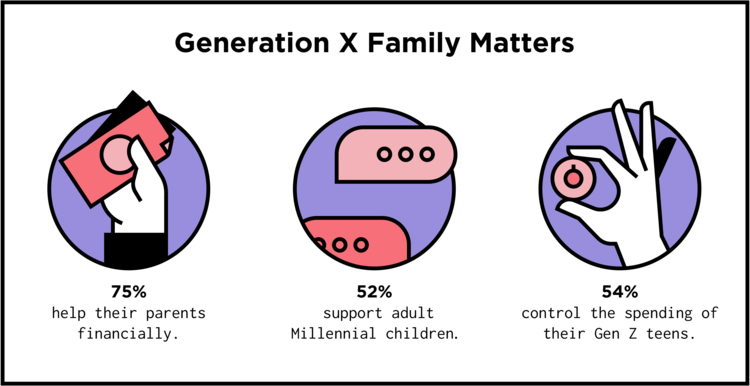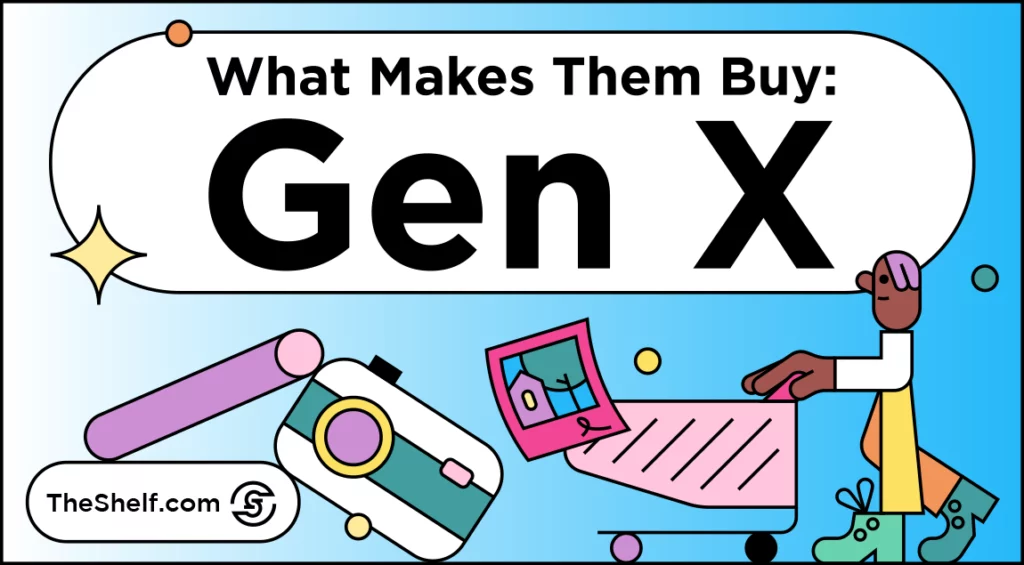Cross Colours Jeans. The Walkman. And gross overuse of the word “alternative”. Just a few of the things that come to mind when we think about the generation birthed largely by Baby Boomers, Generation X.
Born between 1965 and 1980, Gen Xers grew up during an era of sweeping social and economic change. Marketing dollars and ad spend are commonly focused on Millennials, the much-maligned generation that follow Generation X, but there’s a lot to be said about the unique and powerful consumer group known as Gen X.

By the end of this post, you’ll understand how to hold Generation X’s attention, what makes them tick, and how they choose to spend their hard-earned money. You’ll have the elements of an ultra-dope marketing strategy that won’t allow this slept-on generation to look away.
In comparison to other generations, Gen X is relatively small. With only 65 Million people (compared to 70 million Boomers, and 72 million Millenials). They are the first digital natives, and as such, have a deep understanding of how technology can be used to solve problems and make life easier.
They’re also fiercely independent, a quality that has become synonymous with Generation X. But what many brands and marketers miss is that households headed by Gen Xers have an average of $102,512 in disposable income, according to Statista.
So, let’s Get Into the good, the bad, and the ugly of Generation X’s buyer behaviors.
6 Reasons Why Gen Xers Are Both A Marketer’s Wildest Dream, and Worst Nightmare
No. 1: They’re Back-In-The-Dayers
Gen Xers dig nostalgic experiences and are willing to pay a premium for them. That’s why you see so many 90s trends making a comeback in recent years. High-waisted jeans, chokers, and even fanny packs have all made their way back into the fashion consciousness (yes, even fanny packs).
When marketing to Gen X, try to tap into their sense of nostalgia. Use images and language that harken back to their childhoods or teenage years. You can also partner with other brands that have a similar target market. For example, Urban Outfitters has had great success partnering with iconic 90s brands like Calvin Klein and Tommy Hilfiger.
It’s not only fashion that’s making a comeback thanks to Gen Xers. The entire concept of “retro” is being revived by this powerful consumer group. Brands like Big Chill Appliances (@bigchillappliances) are capitalizing on this trend by selling retro-styled refrigerators, stoves, and dishwashers. What’s old is new again, and Gen Xers are leading the charge.
This method of marketing works because it’s a callback to a simpler time. In a world that’s constantly changing and evolving, it can be comforting to hold onto something familiar. That’s why Gen Xers are willing to spend money on experiences and products that remind them of the good old days.
According to scientific research, nostalgia is mostly experienced as a positive emotion. It has the effect of making someone feel good and also increasing their sense of purpose in life. Additionally, it raises self-confidence and hope for the future.
Since nostalgia is essentially a form of escapism, it makes perfect sense that a generation that came of age during some of the most tumultuous years in recent memory would want to escape into simpler times. If done well, nostalgia is a win-win for everyone.
McDonald’s recently released a Happy Meal for Adults in partnership with Cactus Plant Flea Market. The meals, which could be purchased as either Big Mac Meals or 10-piece McNugget meals, came packed in the traditional Happy Meal box (redesigned by the Cactus Plant team) and came with fries, a drink and a throwback McDonald’s mascot toy.

As you’d probably expect, these adult Happy Meals sold out in days in many locations.
A drawback to this tendency is that Gen Xers can be resistant to change. If a brand has been around for decades and has built up a strong reputation, they’re likely to have a loyal Gen X following. These consumers are also more likely to stick with products and services that they know and trust, even if there’s a newer, shinier option on the market.
No. 2: Unbreakable Brand Loyalty
This brings us to point number 2. Gen Xers are ridiculously loyal to their preferred brands. My sister is a Gen Xer, and she holds fast to the belief that JIF is the best brand of peanut butter. That is clearly brand loyalty-based malarky. We all know there are tastier options out there. I said what I said!
She isn’t the only one that holds their favorite brands close to their heart. Gen Xers are more likely than any other generation to be brand-loyal customers. They’re also the most likely to say they would pay more for a product from a brand they trust whether it was endorsed by an influencer or not.
Gen Xers frequently join loyalty reward programs to save money and for a bespoke brand experience, though they often leave programs when it takes too long to rack up points. Except Chick-fil-A. People are just going there for the sauce.
Loyalty programs are a great way to show your appreciation for the Gen X consumer. Many brands offer loyalty cards or apps that give customers points for every purchase they make. These points can then be redeemed for discounts, freebies, or exclusive experiences.
Starbucks recently revamped its loyalty program. After hinting Web3 plans to its investors, the coffee giant announced the offering of limited-edition NFTs for purchase in Starbucks’ Odyssey web app.
The loyalty of Gen X could be a byproduct of their formative years. This is the first generation to come of age with consumerism as we know it. They were raised on advertising and are extremely brand-conscious. For many of them, the brands they grew up with are a big part of their identity.
This intertwining is the reason why it can be difficult to get them to switch, or even acknowledge a brand other than the one they prefer. This can be challenging for marketers present new products to this audience.
Check out our deep dive on What Makes Millennial Parents Buy >>>>
No. 3: Gen X’s Side-Eye Game Is Too Strong
If there’s one thing that characterizes Generation X, it’s skepticism. This is a group that came of age during the Watergate scandal, the Iran-Contra Affair, and the Savings & Loan Crisis. This suspicion often manifests as a healthy skepticism of advertising.
They’ve seen it all, and they’re not going to be taken for a ride, or simply take your word for it. Gen Xers are turned off by pushy sales tactics and marketing that’s too in-your-face. Instead, they respond better to subtlety and humor. They also appreciate authenticity and transparency from the brands they shop.
They’re not going to believe your marketing claims without some solid proof. This is a very research-oriented consumer group. They’re going to read reviews, compare prices, and look for the best deals before they make a purchase; and again, once they’ve decided on a product or service, they’re extremely unlikely to switch to something else.
This means that if you’re trying to sell to them, you need to have your ducks in a row. Make sure your product is top-notch, your prices are competitive, and your customer service is responsive.
Brands need to be able to back up their marketing claims with proof, or they’ll lose Gen Xers’ trust.
If you can appeal to their need for convenience, their love of family, and their sense of responsibility, you’ll be able to tap into their unbreakable loyalty and experience substantial ROI.

No. 4: They’re Do-Gooders
Generation X is known for demanding social responsibility from the brands they buy from. They want to know that the companies they’re supporting are doing their part to make the world a better place. This means that cause marketing is a great way to appeal to them.
Gen X was the first latchkey generation; they were often left home alone after school while their parents worked. The rise in divorce rates during their childhood meant that many of them were raised by a single parent, and they’re known as the latchkey generation because of it. This can lead to a sense of independence, but also feelings of insecurity and anxiety.
It’s also worth noting that this consumer group also came of age during the AIDS crisis, which instilled a sense of social responsibility in many of them. They’re more likely than any other generation to donate time to charitable causes.
Most Gen Xers didn’t have the typical all-fun and games childhood. They grew up a little faster than Boomers did which gave them a certain independence and self-reliance that’s unique to their generation. This also points to the fourth item on our awesome list.

No. 5: Gen Xers Often Head Multi-Generational Households
Gen Xers are extremely family oriented. This is evident in the fact that they’re more likely than any other generation to head a multi-generational household. 28% of Gen Xers are currently doing so. Family is so important that they’re usually the driving force behind the merging of households within their families. Their inherent sense of responsibility often extends to their role as caregivers. This is a consumer group that’s more likely than any other to be caring for both young children and aging parents at the same time.
They’re also more likely to be providing financial support to extended family members. Studies show that members of multi-generational households are less likely to experience poverty. This means that they have a lot of buying power and that their purchasing decisions are often made with the whole family in mind.
Studies show that while millennials used the pandemic years to spend more on experience, and boomers took part in the great resignation, gen Xers kept a level head, held on to their jobs, and spent their money in ways that would improve the lives of their families.
Since they’re often the ones doing the household planning for their families, they’re very attuned to dependable brands that offer products and services that make their lives easier.
Making their life easier is very important to Gen Xers. It’s one of the defining characteristics of the generation. They value convenience and efficiency. Brands like HelloFresh and Blue Apron, which deliver fresh, pre-measured food ingredients and easy-to-follow recipes to your door, are a perfect example of this.

No. 6: The Tech Split
One of the biggest challenges marketers face when trying to target Gen X is the demographics within the demographics. Let me explain. This generation spans between the birth years of 1965 and 1980. This means some of them are old enough to remember life before the internet, while others can’t imagine a world without it.
This difference in tech usage has led to a split in the generation, with those on the younger end being dubbed as being consumed with social media and tech, and those on the older end being disinterested or not as engaged with digital platforms.
This tech usage split has led to two very different groups within Generation X: digital natives and digital immigrants.
Digital Natives are those who grew up with technology. They can’t remember a time when there weren’t computers in every home and cell phones in every pocket. They’re the ones who are always on social media, and they’re very comfortable sharing their personal information online.
Digital Immigrants, on the other hand, are those who didn’t grow up with technology. They remember a time when you had to wait for the dial-up internet to connect, and they’re not as comfortable sharing their personal information online.
This is one of the reasons why some marketers don’t consider Gen X worth the investment. They think that because the generation is split, they won’t be able to reach them all with a single message.
But this isn’t necessarily true. While it’s true that you might have to tailor your message to appeal to either digital natives or digital immigrants, the fact is that both groups are part of Generation X, and they control almost 30% of the United State’s total wealth. This is a stark contrast compared to millennials- who only own 5% of the nation’s wealth.

Marketers often gripe about how difficult it is to target Gen Xers because of this fluid duality. The truth is, though, that being able to reach them across multiple platforms isn’t a bad thing.
Cross-channel living is a way of life for Generation Xers. They will Research the best product and price online to find what they want before heading into the store. Although they communicate much of the day through social media, they acknowledge that some things are better expressed with an old-fashioned handwritten letter.
They logged onto The Sims, Candy Crush, and 2048, but they look fondly on the days of playing Monopoly, Sorry, and Oregon Trail (and occasionally dying of dysentery).
Best Practices: Remember the imminent pivot of the internet from social media websites to AR and VR. They bear witness to the fact that change and more importantly adaptability are the order of the day for marketers targeting this powerful generation.
Before I Go…
During their teen years, they were uninterested in what “the man” was doing to our nation, using the birth of rap, skateboards, grunge, and bags of teen anguish as a means of rebellion. They didn’t need no education. They didn’t need no thought control. These rebel girls and rude boys leaned into their misfit tendencies and redefined teendom.
Their parents may have been a little more hands-off and they’d like to think they turned out just fine. As they’ve aged, they’ve mellowed a bit. They’re doing their best to balance the scales by being ultra-involved in the lives of their kids- even if that means being the embarrassing parent at their kid’s soccer games. They’re also careful to be great children to their elderly parents, taking care of them in their retirement years.
They still don’t need no education, but most of them have found their place in the world. They’re comfortable in their skin and they know what they like. They’re also unapologetic about it. So marketers beware- if you’re going to target this powerful generation, you better know what you’re talking about. Otherwise, they’ll see right through your BS.
You made it through the post! Surprise! Here’s A Bonus-Just For You.

Bonus Insight: Xers Will Become Boomers
Well, not exactly. But they’re aging. This means that their needs are rapidly changing, and marketers need to change with them.
When Gen X became young adults, their focus shifted from being “free and rebellious” to being responsible. They wanted to have it all- successful careers, happy families, and great social lives. And they were willing to work hard to get it.
Now that they’re approaching retirement age, their focus is shifting again. As they age, their priorities shift from raising a family to empty nesting. Health and retirement planning will begin to take precedence over everything else. And as they move into retirement, their spending habits will change once again. Today’s boomers are concerned with making their money last, and they’re much more conservative with their spending. That’s where Gen X is headed. What does this mean for marketers?
This means that marketers need to start thinking about how to appeal to this generation in a way that acknowledges their changing needs, and the changing buying habits of Gen X. They can no longer be marketed to in the same way as younger consumers. Their priorities have shifted, and so must your marketing strategy.
This is a generation that has dealt with a lot of change and they’re still standing. They’re a powerful force to be reckoned with, and marketers would be wise to keep them in mind when targeting consumers. When it comes to marketing to this enigmatic generation- understanding their background is key to success. Keep an eye on the trends, and adjust your marketing accordingly.
Remember households headed by this generation have over a hundred grand in disposable income. This is an astonishingly profitable consumer group that is often overlooked. But, if the mathematically inclined marketer knows what makes them tick, that information places them head and shoulders above the competition.
If you’re not sure how to target Gen X, no worries. We know exactly how to reach them. Just book a strategy call with our marketing team and we’ll get you on the right track. Book a strategy call today. We’ll help you develop a marketing plan that targets Gen X and helps you achieve your business goals.







